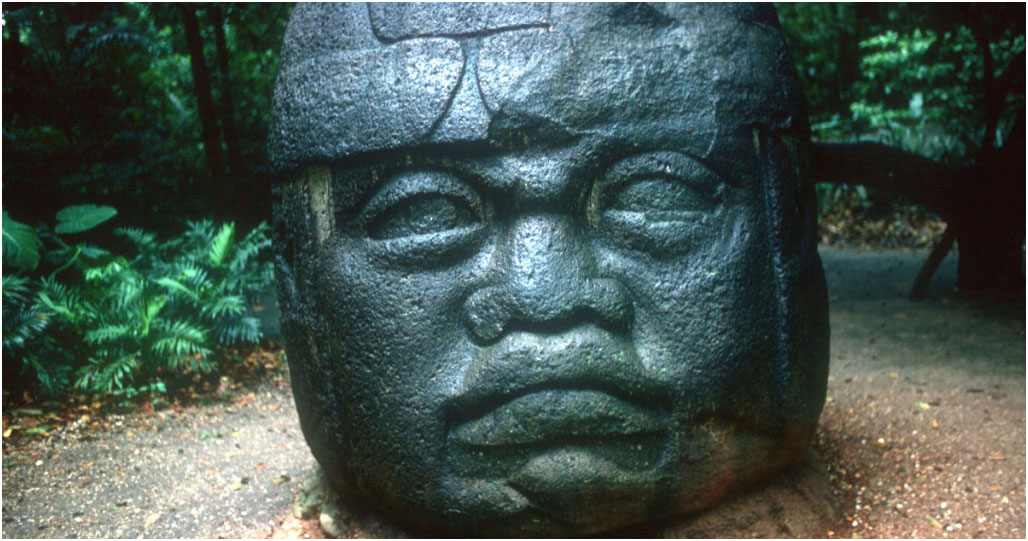
by Simon Griffin
The discovery of a colossal head in the 19th century at TresZapotes in the south-central Gulf Lowlands of Mexico in the Papaloapan River plain spurred the first archaeological investigations of Olmec culture by Matthew Stirling in 1938.
In a Nutshell
The Olmec, Mayan, Incan and Aztec civilizations are some of the greatest ancient civilizations in history, yet we know very little about them compared to other parts of the world. The Olmecs are frequently forgotten entirely, and the rest are often lumped together or confused, but they were all completely distinct. In short, the Maya came first, and settled in modern-day Mexico. Next came the Olmecs, who also settled Mexico. They didn’t build any major cities, but they were widespread and prosperous. They were followed by the Inca in modern-day Peru, and finally the Aztecs, also in modern-day Mexico.
The Whole Bushel
The Maya were the first Mesoamerican civilization, starting around 2600 BCE. They lasted the longest of all and are often viewed as the greatest Mesoamerican civilization. They built most of their great cities between 250 CE and 900 CE. Although they were around first, the Maya only really rose to greatness in those later years after adopting much of their culture from the younger Olmec civilization. The Maya went on to leave behind a longer, more prosperous legacy, encompassing parts of Mexico, Guatamala, El Salvador, Belize and Honduras. They were ruled by kings and priests and were not wiped out like some of the other cultures but gradually dissipated. Their exact relationship with the Olmecs remains unclear.
So, the Olmecs were the first major Mesoamerican culture, despite being younger than the Maya. The name “Olmec” was almost certainly not what they called themselves but is derived from Aztec writings. The Olmecs established themselves around 1400 BCE and lasted about 1,000 years, occupying a reasonably large amount of land. They were good farmers, artists, mathematicians and astronomers. They wrote in hieroglyphics, as did most of the cultures that followed them. They never built any major cities that we know of, but they did leave one pyramid behind before they gradually disappeared. Their most famous legacy is the mystery of the Olmec heads: 9 foot-tall heads resembling African warriors made from stone found over 80 miles away.
The Inca civilization can be traced back to about 1200 CE. They lived in the mountains of Peru, far removed from the Olmecs, Maya and Aztecs, and at the peak of their power, the civilization extended for 2,500 miles and included 16 million people. They were extremely advanced and had an army, laws, roads, bridges, tunnels and a complex irrigation system far ahead of its time. However, they never invented a system of writing, instead using knotted ropes for record-keeping. A civil war over the rightful heir to the throne meant that when the Spanish invaded, the Inca were easily defeated. The empire fell in 1533.
The Aztecs founded their biggest city, Tenochtitlan, in 1325 CE, meaning they were much younger than any of the other three. Tenochtitlan was built on an island in a Mexican lake called Lake Texcoco. They gradually conquered the rest of the area, until they fell in 1521 at the hands of Spanish invaders. Although the Aztecs were not as advanced as the Inca, they did have a 365-day calendar and used hieroglyphics.
Though the cultures are alike in many ways, such as their building of pyramids, human sacrifices and use of hieroglyphics (bar the Inca), they are four distinct cultures that rose and fell at different times for different reasons. To quickly sum up, the Maya were first but learned a lot from the Olmecs, who started 1,200 years later. The Aztecs followed about 400 years after the Mayan civilization began to disintegrate. The Inca were from a completely different area and lasted less than 300 years before being wiped out, while still managing to become the most advanced technologically in their short life span.

Very informative kept uy